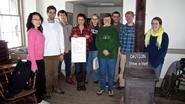
Ben Franklin probably would have loved the Internet. As colonial America’s most famous printer, Franklin ran a shop that served a very similar role to the Internet as we know it today. He dispersed all manner of information to the inhabitants of the colonies: legal documents, newspapers, and publications like Poor Richard’s Almanack, which Franklin himself wrote under the pseudonym of Richard Saunders.
Franklin printed his works on a manual printing press (or “letterpress”)—a machine first perfected by Gutenberg in the mid-15th century. Franklin was passionate about his craft, and his autobiography devotes significant space to his life as a printer, including detailed explanations of technique.
To better understand the way Franklin printed, students in Professor Margaret Thickstun’s Experience of Reading class attended a workshop at the Farmer’s Museum in Cooperstown, N.Y., on Feb. 26. The students were able to experience first-hand how Franklin and others went about their work.
“Spending half a day in a printing house gives students a hands-on experience of the process of printing and so encourages them to think about how the production and consumption of information has changed over time,” Thickstun said.
Ted Shuart, the Museum’s master printer, led the workshop. Shuart was originally a graphic designer, but joined the Farmer’s Museum about 10 years ago. At the time, he had little experience with letterpress printing, although he confesses that the subject always interested him.
“I’ve always been a history buff,” he said, “and this was the closest thing to graphic design in the 1840’s.”
The presses in Cooperstown both date from the mid-19th century, which makes them considerably more contemporary than presses Franklin would have worked on, although the only major differences between Shuart’s presses and Franklin’s is a patented lever that exerts more pressure on the type.
Shuart instructed the students on the essential aspects of the printer’s craft: setting type, inserting proper spacing, and using the press itself. A majority of a printer’s time was spent setting type, which needed to be done upside down and backwards. The printer would have to spell each word out by selecting the proper letters from a case. Large capital letters were located near the top of the case, whereas smaller letters were put closer to the bottom. The way the letters were organized meant that they were referred to “upper case” and “lower case,” respectively, the origin of the modern terms.
After each line of type was set, it was transferred into a metal frame called a “chase.” At this point, wooden spacers would be inserted to fill in any blank space and ensure that the text stayed together. After spacing was inserted and the type was secure, the chase was set on the press and then inked. A clean sheet of paper was placed on top of the inked chase, which was then covered by a frame called a tympan. The entire assembly was then slid under the press.
The pressman would then pull the lever on the press, exerting about 2000 pound of pressure onto the paper and chase, literally pressing the ink into the paper. The tympan was then slid out from under the press, opened, and the printed sheet removed. According to Shuart, two experienced printers could produce 250 sheets an hour.
Students were able to set their own documents, picking out the individual letters and then arranging them as needed. Shuart took care of the spacing, and then students pulled the press themselves. As the students worked, Shuart reminded them that printing was not only a lucrative trade in Franklin’s time, but also an important one: As a printer, you basically controlled the flow of news,” he said. “You had a lot of power.”
At the end of the workshop, students emerged with a newfound appreciation of Franklin’s work.
“The workshop was a great way to see how long and arduous [printing] was,” Alex Hayes ’14 said. “It was so cool to set the type backwards and watch it make legible words on the paper.”
-- John Boudreau '14 is a graduate of Burnt Hills-Ballston Lake High School
Posted March 1, 2011
